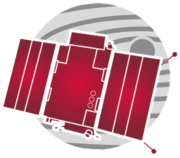cosmos.wikisort.org - Spacecraft
PROBA-2 is the second satellite in the European Space Agency's series of PROBA low-cost satellites that are being used to validate new spacecraft technologies while also carrying scientific instruments.[3] PROBA-2 is a small satellite (130 kg) developed under an ESA General Support Technology Program (GSTP) contract by a Belgian consortium led by Verhaert (now QinetiQ Space) of Kruibeke, Belgium. The nominal mission duration was two years.[1] As of 2022, the mission continues.[4]
| Mission type | Technology Space weather |
|---|---|
| Operator | European Space Agency[1] |
| COSPAR ID | 2009-059B |
| SATCAT no. | 36037 |
| Mission duration | 2 years (planned) 12 years, 8 months and 1 day (in progress) |
| Spacecraft properties | |
| Bus | PROBA |
| Manufacturer | Verhaert Design & Development (now QinetiQ Space) |
| Launch mass | 120 kilograms (260 lb) |
| Dimensions | 0.60m x 0.70m x 0.85m |
| Power | 120 watts |
| Start of mission | |
| Launch date | 2 November 2009, 01:50:00 UTC |
| Rocket | Rokot/Briz-KM |
| Launch site | Plesetsk 133/3 |
| Orbital parameters | |
| Reference system | Geocentric |
| Regime | Sun-synchronous |
| Perigee altitude | 713 kilometres (443 mi)[2] |
| Apogee altitude | 733 kilometres (455 mi)[2] |
| Inclination | 98.28 degrees[2] |
| Period | 99.12 minutes[2] |
| Epoch | 24 January 2015, 13:01:08 UTC[2] |
 ESA solar system insignia for the PROBA-2 mission | |
Mission summary
It was launched on 2 November 2009, with the Rockot launch system together with ESA's SMOS mission.[5] The platform was launched in a sun-synchronous low Earth orbit (altitude of 725 km).[1]
PROBA-2 contains five scientific instruments. Two of them are designated to observe the Sun: "The Sun Watcher using APS and Image Processing" (SWAP, an EUV imager) and the "Large Yield Radiometer" (LYRA), a radiometer made of diamond photodiodes. The Principal investigator teams of both instruments are hosted at the Royal Observatory of Belgium. This institute will also host the PROBA-2 Science Center from which the SWAP and LYRA instruments will be operated and their data distributed. There are three other instruments to measure basic space plasma properties: the Dual segmented Langmuir probe (DSLP)[1] (developed by the Astronomical Institute and Institute of Atmospheric Physics, Academy of Sciences of the Czech Republic), the Thermal Plasma Measurement Unit (TPMU), and the Science Grade Vector Magnetometer (SGVM) developed by the Technical University of Denmark.[1]
See also
- List of European Space Agency programs and missions
- PROBA-1
- PROBA-V
- PROBA-3
References
- "PROBA-2 (Project for On-Board Autonomy-2)". ESA. Retrieved 2013-04-15.
- "PROBA-2 Satellite details 2009-059B NORAD 36037". N2YO. 24 January 2015. Retrieved 25 January 2015.
- "About PROBA-2". ESA. 2012-12-02. Retrieved 2013-04-15.
- "ESA Science & Technology - PROBA2".
- "Successful launch qualification test for PROBA-2". ESA. 2008-09-16. Archived from the original on 2011-07-25. Retrieved 2013-04-15.
External links
На других языках
[de] Proba-2
Proba-2 ist ein Kleinsatellit der ESA, der entsprechend dem Konzept von Proba-1 (engl. Project for On-Board Autonomy für Projekt für Bordautonomie) autonom und kostengünstig operieren soll. Der Start des 130 kg schweren und 0,6×0,6×0,8 Meter großen boxförmigen Satelliten auf eine sonnensynchrone Umlaufbahn in 700 km Höhe erfolgte am 2. November 2009[2] zusammen mit dem SMOS-Satelliten an Bord einer Rockot-Rakete vom russischen Weltraumbahnhof Plessezk aus. Die Mission verbindet Technologietests mit dem Betrieb als wissenschaftliche Sonnenbeobachtungsplattform. Proba-2 untersucht dabei die Sonnenstrahlung und das vom Sonnenwind erzeugte Plasma in der Magnetosphäre der Erde. Außen angebrachte Laserreflektoren ermöglichen die genaue Positionsbestimmung von der Erde aus. Die Kontrolle erfolgt durch ESEC in Redu, Belgien.- [en] PROBA-2
[es] PROBA 2
PROBA 2 (acrónimo de Project for Onboard Autonomy 2, proyecto para autonomía a bordo) es un satélite artificial experimental de la ESA lanzado el 2 de noviembre de 2009 a las 1:50 UTC desde el cosmódromo de Plesetsk mediante un cohete Rokot (también escrito Rokot, Рокот en ruso) junto con el satélite SMOS. PROBA 2 fue liberado de la última etapa del cohete tres horas después de la inserción en órbita de este y unas dos horas después de la liberación de SMOS.[1][ru] Proba-2
PROBA-2 (PRoject for OnBoard Autonomy-2)[1] — второй спутник Европейского космического агентства в серии недорогих спутников PROBA, предназначенных для испытания новых технологий в области космического кораблестроения и проведения научных наблюдений.[2] PROBA2 — маленький спутник весом 130 кг. Разработан бельгийским консорциумом во главе с «Verhaert» (Крёйбеке, Бельгия), в рамках «Основной программы поддержки развития технологий» ЕКА. Номинальная продолжительность миссии составляет 2 года.Другой контент может иметь иную лицензию. Перед использованием материалов сайта WikiSort.org внимательно изучите правила лицензирования конкретных элементов наполнения сайта.
WikiSort.org - проект по пересортировке и дополнению контента Википедии


